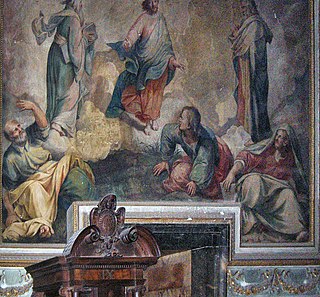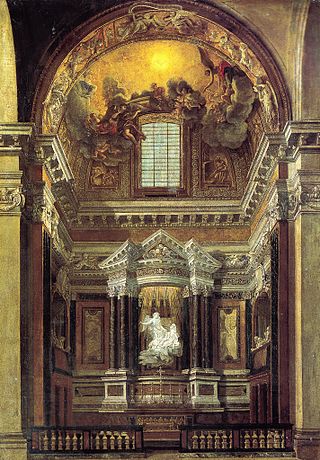
Giovanni Francesco Cassioni was a 17th-century Italian engraver in wood. He was born in Bologna, and made a number of portraits of painters for Carlo Cesare Malvasia to use in his Felsina Pittrice in 1678. [1] [2]

Giovanni Francesco Cassioni was a 17th-century Italian engraver in wood. He was born in Bologna, and made a number of portraits of painters for Carlo Cesare Malvasia to use in his Felsina Pittrice in 1678. [1] [2]

Andrea dell'Asta was an Italian painter of the late-baroque period.
Jacopo Bambini (1582–1629) was an Italian painter of the Baroque period, active mainly in Ferrara.

Simone Barabino was an Italian painter of the late-Mannerist style. Born in Val de Polcevera, near Genoa, he was mainly active in his native city, where he trained with Bernardo Castello. He later feuded with his master and left for Milan, where after some works, he stopped painting. Notable works include San Diego restoring sight to blind child for the Nunziata del Guastato in Genoa and Dead Christ with the Virgin and Saints Michael and Andrew for the church of San Girolamo at Milan. He died in penury. Lanzi says he quit his profession and turned to merchandise, in which he did not succeed, and that be died in prison. The exact date of his death is not known, but he may have been quite old when he died.

Camillo Berlinghieri was an Italian painter of the Baroque period. Born in Ferrara. He trained with Carlo Bononi. Among his paintings was a Gathering of the Manna in San Niccolo; and an Annunciation for Sant Antonio Abbate in Ferrara. His works are chiefly at Ferrara and at Venice, where he was called Il Ferraresino. He died at Ferrara.

Durante Alberti was an Italian painter of the late-Renaissance period.
Ambrogio Besozzi or Giovanni Ambrogio Besozzi (1648–1706) was an Italian painter of the Baroque period.
Angelica or Angiola Veronica Airola was an Italian painter of the Baroque period, active mainly in 17th century Genoa. She was a pupil of the painter Domenico Fiasella. She became a nun of the order of San Bartolommeo dell' Oliveta at Genoa. She painted several works, mainly religious, while in the convent.
Antonio Bacci was an Italian painter of the Baroque period, active in Rovigo as a still life painter. He was born c. 1600 and still alive in Venice in 1665.
Alessandro Badiale (1626–1671) was an Italian painter and engraver of the Baroque period, active in Bologna. He was a pupil of Flaminio Torre. Among his etchings are prints of Virgin seated with the Infant Jesus, between St. Philip Neri and St. Anthony of Padua, a Deposition and a Holy Family after Flaminio Torre. He also made a Madonna with Child, who holds a cross and an apple after Cignani.
Anton Giuseppe Barbazza was an Italian painter and engraver of the Baroque period. He was born in Rome, moved to Bologna, and in 1771 moved to Spain. In Rome, he had engraved the prints for Francesco Bianchini's L'istoria universale provata coi monumenti, published first in 1697 and reissued in 1747.
Giacomo Bargone was an Italian painter of the Baroque period, born and active in Genoa. He trained with Andrea and Ottavio Semini. He excited the jealousy of a contemporary artist, Lazzaro Calvi, who reputedly poisoned him and ransomed his cat for several thousand ducats. He flourished in the 16th century.
Giuseppe Baroni was an Italian engraver of the 18th century. Together with Domenico Rosetti and Andrea Zucchi, he completed the prints for Il gran Teatro delle pitture e prospettive di Venezia, published in Venice in 1720 by Domenico Loviso in the Rialto. In this collection, the Madonna and child print by Nicolas Poussin and the Polyphemus by Pompeo Battoni are attributed to Baroni.
Pier Angelo Basili was an Italian painter of the 16th century Renaissance period. He was born in Gubbio after 1550, and trained with Felice Damiani and Cristoforo Roncalli. He painted in fresco for the cloister of Sant Tibaldo in Gubbio and an oil canvas of Christ preaching for the church of San Marziale. During 1601–1602, he painted frescoes alongside Federico Brunorino in the presbytery of the church of Santa Croce in Gubbio.
Antonio Beduschi was an Italian painter active in the early-Baroque period, mainly in his hometown of Cremona. He imitated the style of Antonio Campi. His sister, Angela Beduschi, was also a painter. In 1602, he painted the Martyrdom of St. Stephen and a Pietà for the church of San Sepolcro in Piacenza.
Lorenzo Bergonzoni was an Italian painter of the Baroque period. He was born and active in Bologna. He was first a pupil of Giovanni Battista Bolognini, but afterwards studied under Guercino in Cento. He is also called Lorenzo Bergunzi. He became known mostly as a portrait painter at Bologna.

Giovanni Maria Bottala (1613–1644) was an Italian painter active in the Baroque period.

Giuseppe Bottani was an Italian painter active in the Baroque period.

Guido Ubaldo Abbatini (1600–1656) was an Italian painter of the Baroque period, active mainly in Rome and Usigni.
Fabio Berardi (1728–1788) was an Italian engraver of the Baroque period, active in Tuscany. He was born in Siena. He went to Venice when young, and trained under Joseph Wagner. Among other works, he engraved in 1767 a booklet of pictures about the life of emperor Francis I. He also engraved the following:
Fra Simone da Carnuli was a (Genoese) painter. He was a Franciscan friar of Genoa. He painted several pictures for his convent, two of which are dated 1519, representing the Last Supper and Preaching of St. Anthony. He painted architectural designs and bird's-eye views with figures seen from an aerial perspective.